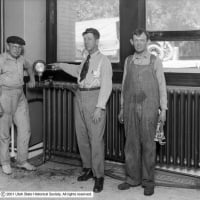Welcome! Here are the website rules, as well as some tips for using this forum.
Need to contact us? Visit https://heatinghelp.com/contact-us/.
Click here to Find a Contractor in your area.
If our community has helped you, please consider making a contribution to support this website. Thanks!
Thickness gauge...
Options
rich pickering
Member Posts: 276
Ever check the actual diameter of numbered drill bits? Some dummy dumped a bunch onto a workbench a while ago. Guess I need to dig out my digital and see how accurate it is. Or how accurate the bits are.
0
Comments
-
I bought a nice Starrett thickness gauge at a garage sale today, but do not know how to read it. Big dial is 0-50. Small dial is 0-5. (with each full rotation of big dial, small one reads one, two, and so on...) Stamp says .0005" How do I read this? I have a dial caliper but it is digital...
Thanks, TimJust a guy running some pipes.0 -
Timco
These are generally used to quickly, yet accurately, check the thickness of plate stock or shims. I am not exactly sure what 0-50 is for your gage(.50, .050, .0050) but they usually do not measure thicknesses over 1" when they go in increments of tenths of thousandths. One I am looking at by Starrett that works up to .500" and reads in .0005" resolution. I assume that this is the one you have. Every mark or line on the gage translates into 5 ten-thousandths of an inch. Of course every two lines will be one-thousands of an inch. Just be careful no to press down too hard on the lever. I hope you didn't pay too much for this item :-). The dial gauges like yours cost around $240 bucks. They are useful when they are needed. I use it to check the thicknesses of various steel covers or shelving to have things custom made. You can accurately tell the fab shop what thickness you want really fast. If I only had more time I would take the day off, go to the supermarket, and accurately check to see who really makes the "thicker picker upper" when it comes to paper towels. Or see who makes the thickest TP. I can only imagine that I am not the only Wally to wonder those things........Man what is in this batch of coffee??? Gotta go see if someone is playing a joke on me!
Mister T0 -
Lots of fun!!
Yes Tim I know the pain. I went through a small bucket of them. Numbers, letters, and decimals all in the same pile. You can get fairly close most of the time by measuring the shank diameter, but the most accurate is the drill diameter. You have to twist it carefully whilst applying slight pressure to the calipers. I usually have the decimal chart right in front of me to speed up the sorting. Just hope no one threw in some metric bits. That confuses you for a bit. Good luck my friend, I feel for you.
Mister T0 -
This could get complicated
Starrett makes a lot of dial indicators for various types of instruments. So the dials and the basic tool might be two separate items. But here's the link to their current catalog, which includes a customer-service number. Hopefully someone there will know what you have.
http://catalog.starrett.com/catalog/catalog/plh.asp
To Learn More About This Professional, Click Here to Visit Their Ad in "Find A Professional"0 -
Sounds like...
.0005" per division on the main dial, .050" per revolution, w/ the little dial .100" (does it take TWO rotations of the main for little to read "1"?) per division and a total range of .500".
Measure something of known dimension, a spark plug or feeler gage, a 1/8" or 1/4" drill bit, etc., or measure a few things w/ the dial caliper and compare to the new gauge -- it should confirm the graduations.
What's the full Starrett P/N?0
This discussion has been closed.
Categories
- All Categories
- 87.4K THE MAIN WALL
- 3.2K A-C, Heat Pumps & Refrigeration
- 61 Biomass
- 429 Carbon Monoxide Awareness
- 120 Chimneys & Flues
- 2.1K Domestic Hot Water
- 5.8K Gas Heating
- 115 Geothermal
- 167 Indoor-Air Quality
- 3.7K Oil Heating
- 77 Pipe Deterioration
- 1K Plumbing
- 6.5K Radiant Heating
- 395 Solar
- 15.7K Strictly Steam
- 3.4K Thermostats and Controls
- 56 Water Quality
- 51 Industry Classes
- 50 Job Opportunities
- 18 Recall Announcements
